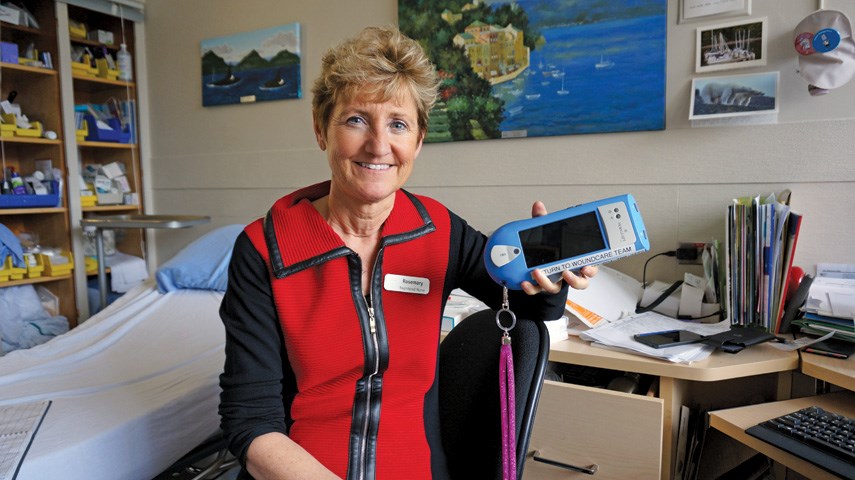A device used by Lions Gate Hospital’s wound care team can literally shine a light on what ails you.
MolecuLight i:X, a kind of bacterial fluorescent imaging device, is touted by wound ostomy continence nurse clinician Rosemary Hill and her team as a tool that helps in their assessments of patient wounds.
“There’s times we look at a wound and we know it’s severe, but it will help guide us in terms of how we’re going to manage that severe wound,” Hill said.
“It enhances our knowledge of what’s going on at the wound bed and enhances our knowledge to the point that it will help us in our dressing selection. It may impact our use of antibiotics in terms of the therapy – how long, whether they’re needed, or when they can be discontinued, and how the wound is responding.”
When a patient has a wound – which could be due to trauma, pressure, surgery, or other factors – the wound care team might use MolecuLight to shine a light on the wound, providing them with a real-time image of the bacteria load in the wound and its precise location.
This helps the team make a more informed decision, Hill said. Does this wound require antibiotics? How long should the treatment be? for example.
“Shining a light, it then indicates where the bacteria is, where you might want a culture, or where you might want to debride – in other words, remove that bacteria or that devitalized tissue,” she said.
But it’s no magic wand, she added, noting that using a bacterial fluorescent imaging device doesn’t replace the foundational aspects of wound care treatment, despite the device’s technological sophistication.
“We ask the patient what’s happening to them. What are their signs and symptoms? Do you have (an) increase in pain? Is there (an) increase in drainage? Is there redness?” Hill explained.
“We always do those basics, that’s foundational when you’re doing wound assessment. We would continue that practice. This just means more information.”
Lions Gate Hospital is the first hospital in Western Canada to use the device, notes a press release from the LGH Foundation.
Hill has also had the opportunity to share the team’s work with the MolecuLight with other clinicians in Canada, Europe and the U.S, including being invited to speak at the Symposium of Advanced Wound Care in San Diego.
While MolecuLight and bacterial imaging devices are a useful tool for wound care team members, nurses, and doctors when they make their assessments, Hill said her favourite aspect of the device is how it boosts patient engagement.
“The benefits in terms of relieving anxiety for patients, that is a huge piece,” she said.
“When you can show the patients: ‘This is what your wound looks like now and see those red areas? OK, in another two days after you’ve been on the treatment plan, let’s shine the light again and see how it’s doing,’ and they’ll go, ‘Wow.’”
Hill is also the president of the Canadian Association for Enterostomal Therapy, a non-profit association that supports the roughly 500 wound, ostomy and continence care nurses around the country.



